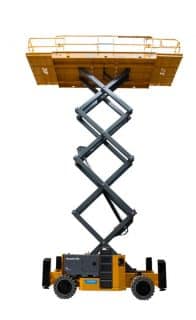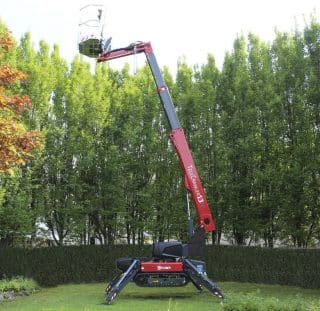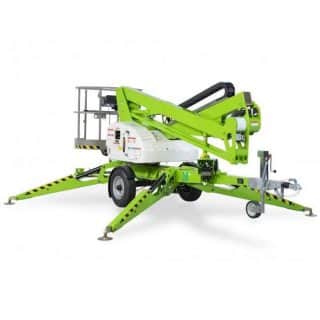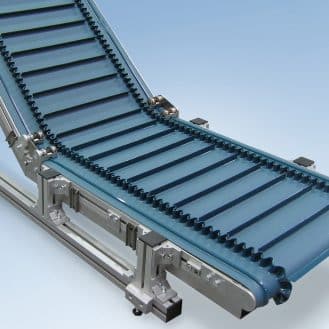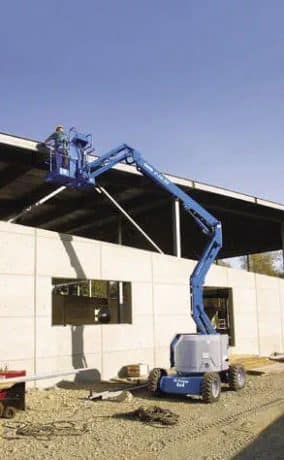
GENIE articulated boom lift
There are several different types of aerial work platforms.
- Work platform or work basket
This type consists only of a working platform with railings, also known as the work basket. It has no lifting mechanism. Lifting is carried out by a load-bearing machine such as a crane or forklift truck.
This is the least expensive option on the market (from €400 to €2,000).
This type of aerial work platform has a work basket mounted at the end of an arm with one or more joints. This configuration gives great freedom of movement, making it easy to get around obstacles and reach hard-to-reach areas.
It can provide a working height of up to 40 meters.
This type of lift is also known as a straight boom lift. Its work basket is placed at the end of a telescopic arm that extends straight out for a direct reach. Compared with other types of aerial work platforms, telescopic boom lifts have the greatest lateral reach, enabling them to access the highest working heights from the ground. Some models also feature a pendulum section at the end of the telescopic arm to facilitate approach in certain situations, such as overhanging work.
It can provide a working height of up to 55 meters.
Scissor lifts are equipped with a scissor mechanism, or a series of criss-crossed folding hydraulic supports, that allow the work platform to rise. Scissor lifts can lift heavy loads (up to 1,000 kg) compared to other types of aerial platforms (an average of 200 kg).
They can provide a working height of up to 20 meters.
This type of lift is ideal for indoor work that doesn’t require too much lateral movement. Mast boom lifts work well in confined, hard-to-reach areas.
They can provide a working height of up to 12 meters.
Spider lifts are equipped with stabilizers integrated into the chassis, which enable them to operate on steep terrain. There are two types of configurations possible for spider lifts: articulated boom lifts with a multidirectional arm and telescopic boom lifts with a telescopic arm.
They can provide a working height of up to 30 meters.
- Vehicle-mounted lift platform
Lift platforms can be mounted on motorized vehicles, such as heavy trucks, light vehicles, small trucks, vans, utility vehicles, pick-up trucks, or tractors. The lifting system can be either a telescopic arm, an articulated arm, or a scissor mechanism.
Lift platforms on light vehicles enable work to be carried out at heights of between 10 and 27 meters.
Lift platforms on heavy trucks enable work to be carried out at heights of up to 70 meters.
Suspended platforms, or suspended scaffolds, consist of a work platform suspended by cables and hoists. Unlike other types of aerial work platforms, suspended platforms are not operated from the ground, but from an elevated point, such as the roof of a building. This allows for work to be carried out at heights of over 100 meters. Suspended platforms can be installed temporarily or permanently, for example, to carry out periodic maintenance on a building.

